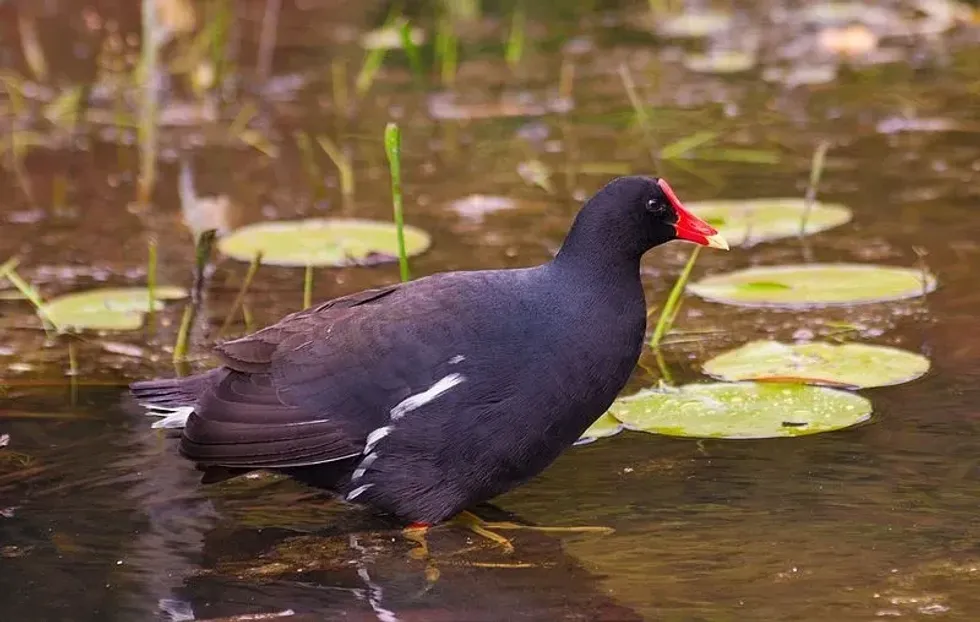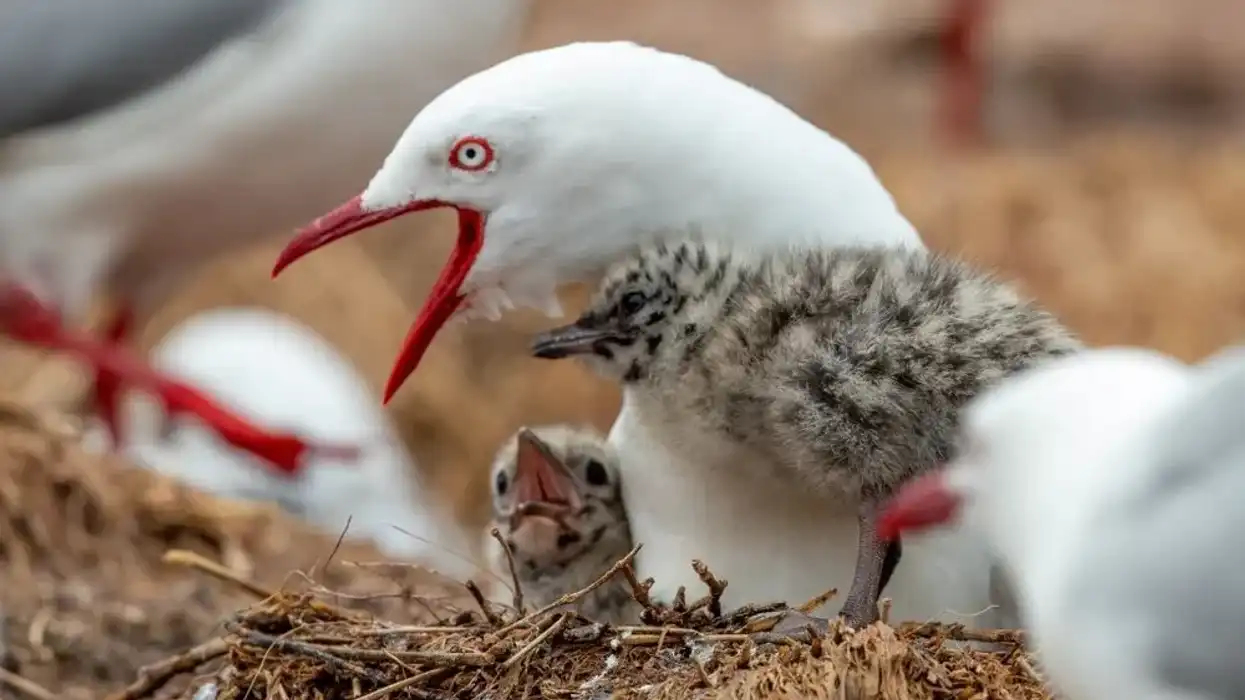If you are interested in North American birds, then you must have heard of the common gallinule. The common gallinule (Gallinula galeata) is a bird that you can find among marsh vegetation and on open water.
You may have already seen this bird near a marsh or aquatic vegetation flaunting their red bill and yellow toes. They are a similar species to the common moorhen.
With a red bill and red shield on its forehead and yellow toes, the common gallinule does stand out.
In the common gallinule vs. common moorhen debate, these were once considered to be another species of the common moorhen, but the American Ornithologists' Union split up the common gallinule from the common moorhen in 2011. The common gallinule can be pronounced as /ˈɡælɪnjuːl/.
So, the common gallinule pronunciation should be gal-lee-new-le. There is also another kind of gallinule called the purple gallinule.
However, the purple gallinule is different from the common gallinule.
Any bird guide or field guide would state that the population of purple gallinule is around 10,000, but a bird guide would also suggest that because of the fragmented manner in which the population is distributed, they can be rare. The common gallinule lives in marshlands for the most part and also relies on the emergent marsh vegetation.
It is hunted for food and has quite a wild taste but is quite delicious. If you want to know more about this marsh bird with a red bill and yellow toes, its lifestyle, and breeding, then read on.
If you like this article, then you may also like the monk parakeet and the quetzal.
Common Gallinule Interesting Facts
What type of animal is a Common Gallinule?
The common gallinule (Gallinula galeata) is a type of aquatic bird, which looks similar to the common moorhen.
What class of animal does a Common Gallinule belong to?
The common gallinule (Gallinula galeata) belongs to the class Aves, from order Gruiformes, family Rallidae.
How many Common Gallinules are there in the world?
According to IUCN, or The International Union for Conservation of Nature, the current global population of the common gallinules is quite stable, there are an estimated 2 million individual common gallinules.
Where does a Common Gallinule live?
The common gallinule generally prefers inland waters or marine systems. They can be mostly found both in North America and South America, with their range map stretching from Canada to Chile.
What is a Common Gallinule's habitat?
The common gallinule is an aquatic bird and hence, prefers the marine habitat. They are generally found in wetlands, marshes, coastal areas, open water ponds, and lakes. These areas should have a lot of aquatic vegetation. Even rice fields and artificial ponds are also certain areas where you can find the common gallinule.
Who do Common Gallinules live with?
Common gallinules from North America are known to be territorial species and tend to live in pairs. Often, they may go foraging for vegetation as groups. They form these groups during the winter period, and they can form a group of 30 gallinules. They can group up with species of ducks and American coots too.
How long does a Common Gallinule live?
The common gallinule species has an average lifespan of around 11 years.
How do they reproduce?
The breeding season in South and North America is generally from April to June. The male and female common gallinule form pairs with each other. They lay up to 15 eggs per clutch size.
Generally, they have one or two broods, and the incubation period of the eggs is around 19-22 days. When it comes to raising their offspring, these species tend to take a more cooperative approach. Mothers can share their nest with the daughter to help raise the baby.
What is their conservation status?
As per the IUCN or The International Union for Conservation of Nature, the conservation status of the common gallinule species is Least Concern. However, there can be a decline in their numbers due to the destruction of wetlands (one of their preferred habitat).
The species has faced an annual decline of 1.5% from the year 1966 to 2015 as per the North American Breeding Bird Survey.
However, these species are quite adaptive. While wetlands and vegetation may have declined in certain areas, the species have adapted properly by settling down in rice fields or open water retention ponds.
Common Gallinule Fun Facts
What do Common Gallinules look like?

The color shades of the immature common gallinule and an adult one are quite different. The immature common gallinule is mostly dark gray with a brownish tinge.
They carry a white stripe that can act as their identifier. They don't have a bright red bill or a shield-like extension on their face. During the common gallinule juvenile stage, they are mostly pale brown, and the shield starts forming.
The adult common gallinule has a charcoal gray shade with a red bill. The red bill extends towards the forehead to form a forehead shield. Stripes of white shades color the tail ends and the ends of the wing feathers.
As an adult, they have yellow long toes to help them walk in the mud. Their yellow toes are also a distinguishing factor.
How cute are they?
A plump common gallinule can look quite cute. Their cuteness is mostly focused on their bright red beak and forehead shield. However, since their colors are dull, they do not rate high on the cuteness factor.
How do they communicate?
The common gallinule call is not different from any other bird. The common gallinule makes a variety of sounds like clucking calls, cackling calls, and squawk calls. If you are going into the marsh, you can often hear their calls from their hiding spots.
Their squawking can be both high-pitched or low-pitched. Since they mix their different sounds, it can sound like a series of squawks happening in one go and thus, may sound like a laugh. These species tend to be quite loud when the breeding season comes.
How big is a Common Gallinule?
The common gallinule has a length of around 12.6-13.8 in (32-35 cm). When you compare it with a mallard, they seem quite small. This is because a mallard is quite big at 19.7-25.6 in (50-65 cm).
How fast can a Common Gallinule fly?
The common gallinule does not favor flight. Generally, if they happen to fly, their flight will be very slow, as if they are trying their hardest to keep themselves in the air. For the common gallinule, flying may seem laborious.
How much does a Common Gallinule weigh?
The common gallinule has a healthy weight of 10.9-16.1 oz (310-456 g).
What are their male and female names of the species?
There is no specific male or female name of the common gallinule. However, as they are birds, the male can be called a cock, and the female can be referred to as a hen.
What would you call a baby Common Gallinule?
A baby common gallinule can be referred to as a chick.
What do they eat?
Since the common gallinule is omnivorous, they generally consume small fish, earthworms, crustaceans, insects, and spiders. Sometimes, it has been noticed that they consume bird eggs too. The common gallinule also eats fruits and berries of rosa and yew, moss, water lilies, reeds, and many other emergent aquatic vegetation.
Are they dangerous?
The common gallinule is not very dangerous. There have not been any major records of common gallinules causing danger to human beings. On the other hand, it has been noticed that if a common gallinule feels threatened, the bird will run away as quickly as it can.
Would they make a good pet?
While the common gallinule can be tamed, they are not usually considered pets. They require a wetland habitat to survive.
Did you know...
A subspecies of the common gallinule found in Hawaii is known as the Hawaiian gallinule. This bird is also known as alae ula and is part of Hawaiian legend.
Due to their red shield, it is said that the alae ula brought fire to human beings. Since they brought fire to us, as per the legend, the forehead of the alae ula is scorched.
The common gallinule generally takes up short-distance migrations and migrates at night.
Is a gallinule a duck?
A common gallinule is not a duck.
One of the similarities between the duck and a common gallinule is in their swimming method. The common gallinule, like the duck, pushes their head forward when they are swimming. Their tail remains horizontal during this process.
However, unlike ducks, they don't have webbed feet but long, yellow toes. But they can still swim well.
What color is a common gallinule bird?
An adult common gallinule is a charcoal gray color, while a young common gallinule can be darker shades of gray.
Here at Kidadl, we have carefully created lots of interesting family-friendly animal facts for everyone to discover! Learn more about some other birds including the California quail and the eastern kingbird.
You can even occupy yourself at home by drawing one of our Common Gallinule coloring pages.










